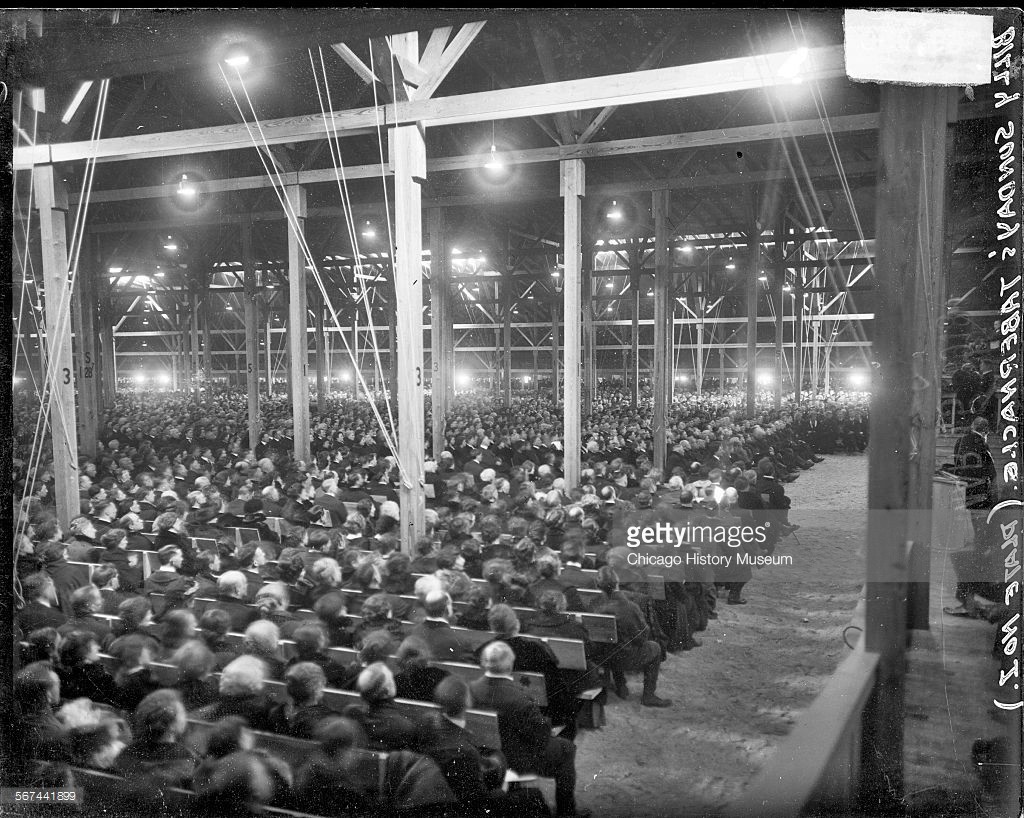By 1901, the pro-baseball-player-turned-revivalist Billy Sunday was popular enough that construction of large wood tabernacles would begin to be constructed months in advance of his revival. They were large enough to hold up to 10 percent of a population in a smaller city, and up to 20,000 people in major cities.
The aisles of the earthen floor of the tabernacle were covered with sawdust, which accomplished several purposes. It was less expensive than constructing temporary wooden floors. In an age before air conditioning—or antiperspirants!—it could be swept out and refreshed with a fresh new smell throughout the tabernacle.
But the most significant reason was explained in 1917 by newspaper man Theodore Thomas Frankenberg, whose book on Billy Sunday explained the architecture of the tabernacles and the importance of acoustics:
The prime requisite in every instance is the best possible accommodation of a single voice. To this end, lofty ceilings are abandoned and low straight roofs are used. The platform or speaking pulpit is pushed as far as possible toward the center of the auditorium. Necessity as much as anything else gave rise to the famous “sawdust trail.” Where thousands of people are gathered together even an occasional shuffling of feet is a serious disturbance. No sort of floor is noiseless, certain none that is possible in a temporary structure—therefore the sawdust covering. This is absolutely soundless and by giving it a base of tamped tanbark it is also impervious to fire.
Ma Sunday, Billy’s wife, traced the terminology of “hitting the sawdust trail” back to a tabernacle revival in Bellingham, Washington, in 1910:
Billy had been preaching for seven or eight nights . . . without giving an invitation, and finally he decided that it was time to give one. And, as people started to go forward and take Billy’s hand to accept the Lord Jesus Christ as their Savior, some man spoke up aloud in the meeting and said, “oh, they’re hitting the sawdust trail.”
Lyle Dorsett, in Billy Sunday and the Redemption of Urban America, explains the cultural context of the term:
In those days lumberjacks would enter a deep, dark forest to scale the timber or calculate how much could be cut from an area. Because it was virgin territory, there were no trails by which to enter and return. Rather than use a compass, the lumberman carried bags of sawdust on their shoulders. As they entered the woods, they left a trail of sawdust so they could easily retrace their steps to their point of entry.
Mrs. Sunday commented:
In that country, that sawdust trail represents coming from what would have been a lost condition to a saved condition—from a dark, uninteresting and unsatisfactory place to back home, to light, and comfort, and friends and family.
William Ellis, writing about Billy Sunday and his revivals in 1914, explains how the literal and metaphorical uses of “sawdust trail” came together:
Pioneers are necessarily unconventional. America has done more than transform a wilderness into a nation: in the process she has created new forms of life and of speech. Back from the frontier has come a new, terse, vigorous and pictorial language. Much of it has found its way into the dictionaries. The newer West uses the word “trail”—first employed to designate the traces left by traveling Indians—to designate a path. The lumbermen commonly call the woods roads “trails.”
Imagine a lumberman lost in the big woods. He has wandered, bewildered, for days. Death stares him in the face. Then, spent and affrighted, he comes to a trail. And the trail leads to life; it is the way home.
There we have the origin of the expression “Hitting the sawdust trail,” used in Mr. Sunday’s meetings as a term similar to the older stereotyped phrases: “Going forward”; “Seeking the altar.” The more conventional method, used by the other evangelists, is to ask for a show of hands.
Out in the Puget Sound country, where the sawdust aisles and the rough tabernacle made an especial appeal to the woodsmen, the phrase “Hitting the sawdust trail” came into use in Mr. Sunday’s meetings. The figure was luminous. For was not this the trail that led the lost to salvation, the way home to the Father’s house?
The metaphor appealed to the American public, which relishes all that savors of our people’s most primitive life. Besides, the novel designation serves well the taste of a nation which is singularly reticent concerning its finer feelings, and delights to cloak its loftiest sentiments beneath slang phrases. The person who rails at “hitting the trail” as an irreverent phrase has something to learn about the mind of Americans. Tens of thousands of persons have enshrined the homely phrase in the sanctuary of their deepest spiritual experience.
For a detailed and evocative description of what it was like to witness this, you can read Ellis’s whole description.


















